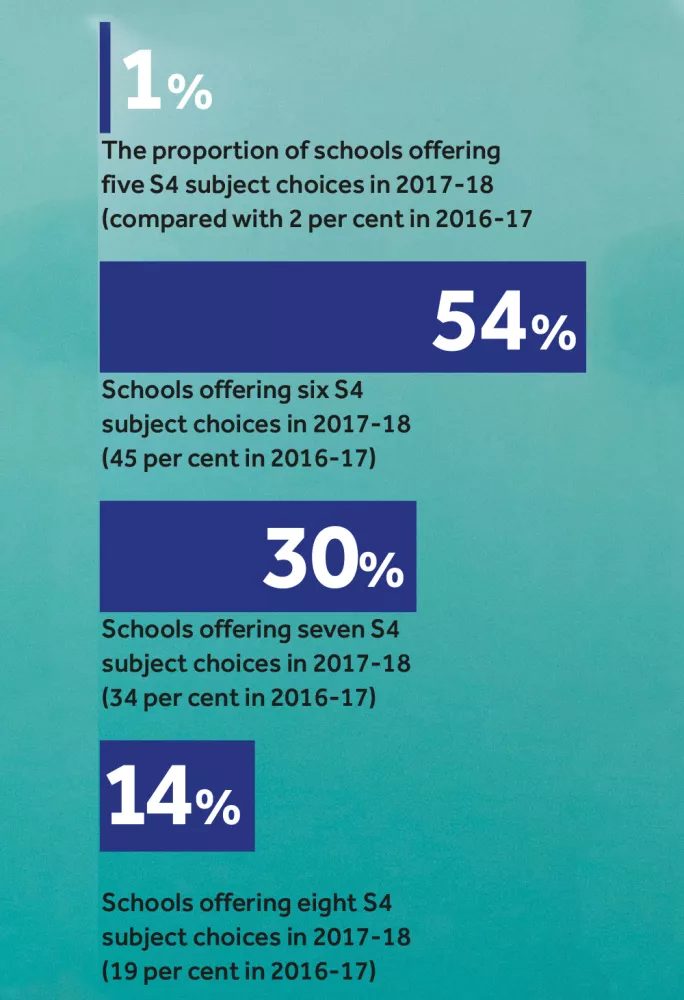Education directors deny choice is narrowing in S4

Education directors have rejected the idea that senior secondary students’ subject options are narrowing - and claim that current approaches to organising the curriculum may actually give pupils a broader range of opportunities.
Terry Lanagan, of education directors’ body ADES, admits it may appear on the surface that options are narrowing but says closer inspection reveals this is not the case. His view is in direct contrast to widely held fears that, by offering fewer subjects at S4, most schools and local authorities are reducing the range of opportunities available to young people (see “‘Inequity for students’ as secondary subject options narrow”, bit.ly/InequitySec).
Those concerns were raised again last week at the Scottish Parliament’s Education and Skills Committee. Oliver Mundell, Conservative MSP for Dumfriesshire, said it was a particular issue in rural constituencies, where it was harder for schools that were often distant from each other to pool their efforts and offer more subjects and greater curricular flexibility.

However, Lanagan, a former education director of West Dunbartonshire, told MSPs: “While it might look as if the choice is narrowing in the senior phase, if you actually dig a bit deeper, you find that’s not the case.”
He added: “If I think back to the age of Standard Grades, you had, generally speaking, eight subjects in S4, and a maximum of five in S5 and S6, making a total of 18. The most common pattern now is six subjects in S4 - although some do seven and some still do eight - but then up to six subjects in S5 and S6 are possible in the timetable, making a total of 18.”
The advantage of this “6-6-6” approach, according to Lanagan, is that S4-6 students can be timetabled together, which “increases the choice available” and “makes some courses actually more viable”. He said that schools taking such an approach were reporting that the motivation and behaviour of S4 pupils was improving as a result of sharing classes with S5 and S6 students.
Vocational boost
Lanagan believes such approaches make it easier for students to fit in vocational courses run by FE colleges. “You actually increase the possibility of youngsters accessing college because there’s a bigger block of time for each subject,” he said. “In the eight-subject models…it often wasn’t possible to timetable a college course in S4.”
Mundell remains unconvinced, however. “What you say doesn’t seem to match up with the reality of pupils in my own constituency,” he said, adding that choices in schools were better 10 years ago and that “digital solutions haven’t arrived” in rural areas.
Lanagan responded: “There are always going to be additional challenges in rural areas where schools are further apart.”
In the same Education and Skills Committee meeting, Euan Duncan, a professional officer for the Scottish Secondary Teachers’ Association, said of the reduction in numbers of subjects offered: “I must say, I’m not a fan of that. I think a broad education is very valuable.” But he added that, while the decrease in subject options was “narrowing choice”, there were advantages arising from “schools being able to align their timetable” with colleges.
In March, Tes Scotland reported analysis by Professor Jim Scott, an expert on curricular structures at the University of Dundee, which found that more than half of secondary schools built their S4 timetables around six subjects.
In response to Lanagan’s comments, Scott says that the 6-6-6 model - regardless of its merits or otherwise - is “by no means universal” in Scottish secondaries. He surmises that its main selling point seems to be that it is “highly efficient in staffing”, as he has seen little evidence of any educational benefits.
Scott, a former secondary headteacher, regards the arguments for 6-6-6 as an exercise in “defending the indefensible”. He adds: “There are, of course, clear staffing savings to be made for schools and local authorities in adopting a simplified curriculum.”
He also argues it is “simply not true” that offering fewer subjects at S4 makes it easier to timetable college courses.
You need a Tes subscription to read this article
Subscribe now to read this article and get other subscriber-only content:
- Unlimited access to all Tes magazine content
- Exclusive subscriber-only stories
- Award-winning email newsletters
Already a subscriber? Log in
You need a subscription to read this article
Subscribe now to read this article and get other subscriber-only content, including:
- Unlimited access to all Tes magazine content
- Exclusive subscriber-only stories
- Award-winning email newsletters